Uncategorized
Crypto Daybook Americas: China’s DeepSeek Sends Bitcoin, AI Tokens, Stocks Tumbling

By Omkar Godbole (All times ET unless indicated otherwise)
Last week, we described bitcoin above $100,000 as a coiled spring ready to unleash energy in either direction. Unfortunately for the bulls, that energy is being released downward as market sentiment shifts in response to concerns over the impact of the low-cost Chinese AI startup DeepSeek on the U.S. AI sector and American technological leadership.
Bitcoin plummeted to $97,800 during Asian trading hours, with whales driving prices lower to liquidate overleveraged buyers on perpetual futures exchanges. GPU-heavy AI tokens saw sell-offs of up to 40%, with similar pressure affecting GameFi assets.
Nasdaq futures tanked 700 points, with shares in chipmaker Nvidia (NVDA) indicated 10% lower in pre-market trading. DeepSeek-R1 is expected to significantly reduce the costs of developing large language models, raising a questions on the validity of the rich valuations for AI-associated companies like Nvidia.
Trader and analyst Alex Kruger noted on X, «The problem is, few understand how DeepSeek changes things. it’s hard to quantify the issue—and when facing uncertainty, people derisk. When this happens in low liquidity conditions, the market flushes hard.»
Kruger is opting not to buy the dip, saying he prefers to short positions above $100,000 as he anticipates heightened volatility from the upcoming Fed meeting and potential political maneuvering from President Donald Trump. The Fed is expected to reiterate its wait-and-see approach, maintaining its hawkish December guidance on interest rates.
Still, all is not lost. Paul Howard, Senior Director at Wincent, said institutional participation could ramp up in the coming months.
«The next wave up will likely come from organic participation from institutions in the next 3-4 months. I’d be surprised to see a sharp bounce back to all-time highs before Q2,» he said in an email.
Howard identified newly launched layer-1 blockchains with a focus on security and transactions per second, like SUPRA, as valuable opportunities, while stressing that for long-biased funds, discovering alpha in a bearish market involves seeking out low market-cap layer-1s alongside their already established peers. Stay alert!
What to Watch
Crypto:
Jan. 27 (provisional): Abstract, an Ethereum L2, has its mainnet launch, which is expected to expand the reach of the Pudgy Penguins project beyond NFTs.
Jan. 28, 1:00 p.m.: Hedera (HBAR) network upgrade to v0.57.5.
Jan. 29: Cardano’s Plomin hard fork network upgrade.
Jan. 29: Ice Open Network (ION) mainnet launch.
Feb. 2, 8:00 p.m.: Core blockchain Athena hard fork network upgrade (v1.0.14)
Feb. 4: MicroStrategy Inc. (MSTR) Q4 FY 2024 earnings report.
Feb. 4: Pepecoin (PEPE) halving. At block 400,000, the reward will drop to 31,250 PEPE.
Feb. 5, 3:00 p.m.: Boba Network’s Holocene hard fork network upgrade for its Ethereum-based L2 mainnet.
Feb. 6, 8:00 a.m.: Shentu Chain network upgrade (v2.14.0).
Feb. 12: Hut 8 Corp. (HUT) Q4 2024 earnings report.
Feb. 15: Qtum (QTUM) hard fork network upgrade is scheduled to take place at block 4,590,000.
Feb. 18 (after market close): Semler Scientific (SMLR) Q4 2024 earnings report.
Feb. 20: Coinbase Global (COIN) Q4 2024 earnings report.
Macro
Jan. 27, 10:00 a.m.: The U.S. Census Bureau releases December 2024’s Monthly New Residential Sales report.
New Home Sales Est. 0.67M vs. Prev. 0.664M.
New Home Sales MoM Prev. 5.9%.
Jan. 28, 8:30 a.m.: The U.S. Census Bureau releases December Monthly Advance Report on Durable Goods Manufacturers’ Shipments Inventories and Orders.
MoM Est. 0.8% vs. Prev. -1.1%.
Jan. 28, 1:00 p.m.: The Fed releases December’s H.6 (Money Stock Measures) report.
Money Supply Prev. $21.45T.
Jan. 29, 12:00 a.m.: Japan’s Cabinet Office releases January’s Consumer Confidence Survey.
Consumer Confidence Index Est. 36.5 vs. Prev. 36.2.
Jan. 29, 4:00 a.m.: The European Central Bank (ECB) releases December 2024’s Monetary Developments in the Euro Area report.
M3 Money Supply YoY Est. 3.8% vs. Prev. 3.8%.
Jan. 29, 8:45 a.m.: The Bank of Canada (BoC) releases the (quarterly) Monetary Policy Report.
Jan. 29, 9:45 a.m.: The BoC announces its interest rate decision.
Est. 3% vs. Prev. 3.25% followed by a press conference at 10:30 a.m.
Jan. 29, 2:00 p.m.: The Federal Open Market Committee (FOMC) announces the U.S. central bank’s latest interest rate decision.
Target Range for the Federal Funds Rate Est. 4.25% to 4.5% vs. Prev.: 4.25% to 4.5% followed by a press conference at 2:30 p.m. Livestream link.
Token Events
Governance votes & calls
Compound DAO is voting whether to implement interest-rate curve adjustments for Stablecoin Comets across multiple networks, including Ethereum and Base.
Clover Finance DAO is voting whether to rebrand the CLV Network to Lucent Network to align with a pivot toward building a decentralized finance and artificial intelligence platform (DeFAI). The rebrand would include a migration from Polkadot to an SVM chain and a new token ticker, LUX.
Arbitrum DAO is voting on a proposal to establish the Arbitrum Strategic Objective Setting (SOS), which would allow DAO members to propose and vote on short to mid-term objectives.
Unlocks
Jan. 31: Optimism (OP) to unlock 2.32% of circulating supply worth $52.9 million.
Jan. 31: Jupiter (JUP) to unlock 41.5% of circulating supply worth $626 million.
Feb. 1: Sui (SUI) to unlocked approximately 2.13% of its circulating supply worth $226 million.
Token Listings
Jan. 28: Pudgy Penguins (PENGU) and Magic Eden (ME) to be listed on Kraken.
Jan. 29: Cronos (CRO), Movement (MOVE) and Usual (USUAL) to be listed on Kraken.
Conferences:
Jan. 29-31: Crypto Peaks 2025 (Palisades, California)
Jan. 30, 12:30 p.m. to 5:00 p.m.: International DeFi Day 2025 (online)
Jan. 30-31: Ethereum Zurich 2025
Jan. 30-31: Plan B Forum (San Salvador, El Salvador)
Jan. 30 to Feb. 1: Crypto Gathering 2025 (Miami Beach, Florida)
Jan. 30-Feb. 1: CryptoXR 2025 (Auxerre, France)
Jan. 30-Feb. 2: Oasis Onchain 2025 (Nassau, Bahamas)
Jan. 30-Feb. 4: The Satoshi Roundtable (Dubai)
Feb. 1-28: Mammathon (online), a global hackathon for Celestia (TIA).
Feb. 3: Digital Assets Forum (London)
Feb. 5-6: The 14th Global Blockchain Congress (Dubai)
Feb. 6: Ondo Summit 2025 (New York).
Feb. 7: Solana APEX (Mexico City)
Feb. 13-14: The 4th Edition of NFT Paris.
Feb. 18-20: CoinDesk’s Consensus Hong Kong
Feb. 19: Sui Connect: Hong Kong
Feb. 23-March 2: ETHDenver 2025 (Denver, Colorado)
Feb. 25: HederaCon 2025 (Denver)
Token Talk
By Shaurya Malwa
AI-themed agents and memes took a thumping Monday, with stalwarts Virtuals Protocol (VIRTUALS), ai16z (AI16Z) and eliza (ELIZA) sliding as much as 30% as China’s DeepSeek led to a reiteration of U.S. AI startup valuations.
The downturn dented massive Sunday rallies on Jupiter’s JUP and Base memecoin toshi (TOSHI).
JUP spiked 40% as founder ‘Meow’ announced at an annual conference that the platform would burn over $3 billion JUP tokens and begin using 50% of its fees to buy back the tokens from the market.
TOSHI more than doubled as Coinbase listed perpetual futures for the token, making it the only Base memecoin with both a spot and futures listing on the influential exchange.
The subsequent spike in demand sent the token to a peak market capitalization of $820 million.
Derivatives Positioning
BTC perpetual funding rates flipped negative during European hours, showing a net bias for shorts. Historically, such a positioning has tended to mark local price bottoms.
BNB, DOGE, TRX and AVAX also saw negative funding rates.
BTC, ETH short-dated options now show a bias for put options, offering downside protection. Expiries after February continue to show a bias for calls.
Key block trades for the day include a short volatility play, involving short positions in BTC $05K call and $98K put, both expiring on Jan. 10. In ETH’s case, shorts in out-of-the-money calls and a long position in the $3K put has been noted.
Market Movements:
BTC is down 5.95% from 4 p.m. ET Friday to $98,784.45 (24hrs: -5.84%)
ETH is down 6.12% at $3,050.20 (24hrs: -7.88%)
CoinDesk 20 is down 9.07% to 3,536.28 (24hrs: -9.66%)
CESR Composite Staking Rate is down 2bps to 3.1%
BTC funding rate is at 0.0006% (0.7% annualized) on Binance
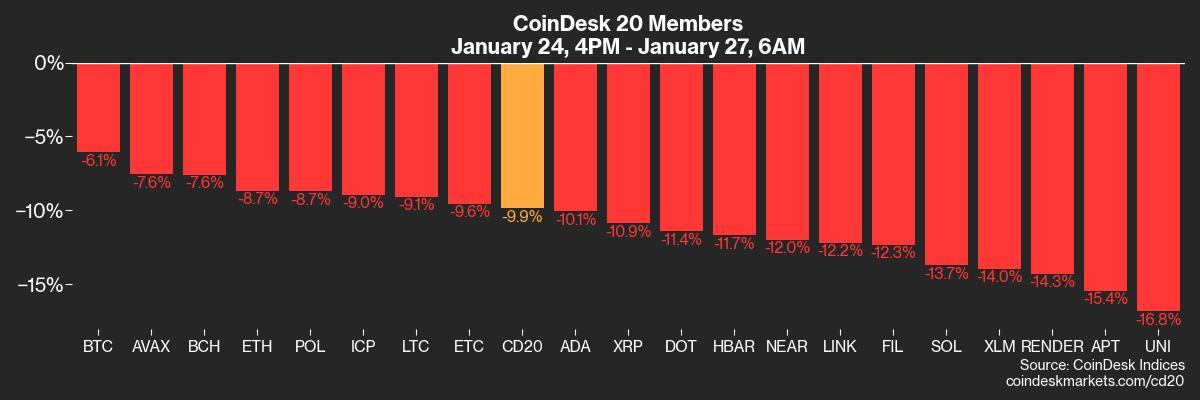
DXY is down 0.26% at 107.17
Gold is down 0.21% at $2,767.13/oz
Silver is down 0.55% to $30.48/oz
Nikkei 225 closed -0.92% at 39,565.80
Hang Seng closed +0.66% to 20,197.77
FTSE is down 0.21% at 8,483.97
Euro Stoxx 50 is down 1.51% at 5,140.89
DJIA closed on Friday -0.32% to 44,424.25
S&P 500 closed -0.29% at 6,118.71
Nasdaq closed -0.5% at 19,954.30
S&P/TSX Composite Index closed +0.14% at 25,468.49
S&P 40 Latin America closed +0.53% at 2,322.63
U.S. 10-year Treasury was down 13 bps at 4.5%
E-mini S&P 500 futures are down 2.37% at 5,988.00
E-mini Nasdaq-100 futures are down 4.27% at 20,974.75
E-mini Dow Jones Industrial Average Index futures are unchanged at 44,216.00
Bitcoin Stats:
BTC Dominance: 59.45 (0.60%)
Ethereum to bitcoin ratio: 0.0392 (-1.7%)
Hashrate (seven-day moving average): 766 EH/s
Hashprice (spot): $60.2
Total Fees: 4.19 BTC/ $439,954
CME Futures Open Interest: 187,465 BTC
BTC priced in gold: 35.8 oz
BTC vs gold market cap: 10.17%
Technical Analysis
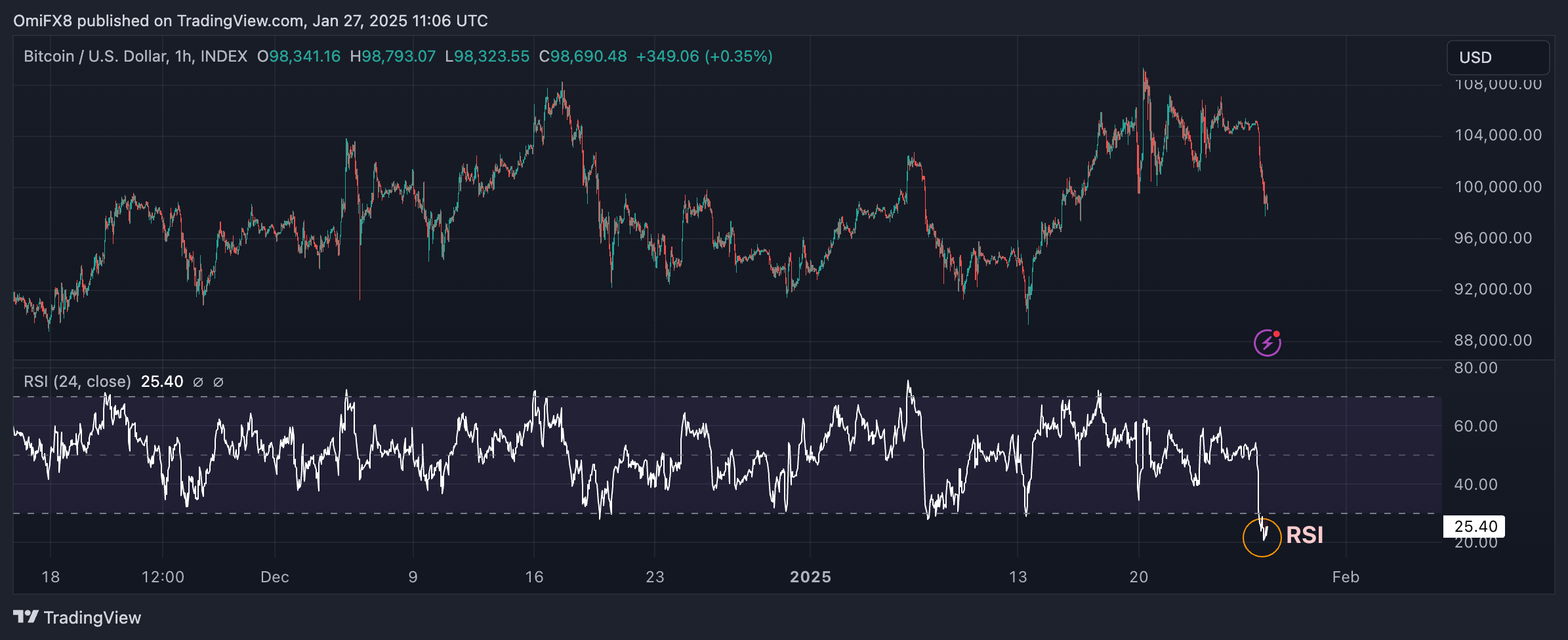
The RSI on the hourly chart dropped to 20 during the Asian hours, the lowest since late August.
In other words, bearish momentum was the strongest in nearly five months.
RSI readings below 30 are taken to represent oversold conditions and a sign of an impending bear breather.
Crypto Equities
MicroStrategy (MSTR): closed on Friday at $353.67 (-5.11%), down 4.9% at $336.35 in pre-market.
Coinbase Global (COIN): closed at $298.00 (+0.67%), down 4.9% at $283.39 in pre-market.
Galaxy Digital Holdings (GLXY): closed at C$32.52 (-4.18%)
MARA Holdings (MARA): closed at $19.99 (+0.2%), down 6.1% at $18.77 in pre-market.
Riot Platforms (RIOT): closed at $13.54 (+4.23%), down 6.94% at $12.60 in pre-market.
Core Scientific (CORZ): closed at $15.98 (-2.2%), down 15.33% at $13.53 in pre-market.
CleanSpark (CLSK): closed at $11.53 (+1.05%), down 6.76% at $10.75 in pre-market.
CoinShares Valkyrie Bitcoin Miners ETF (WGMI): closed at $26.22 (+2.22%), down 8.28% at $25.05 in pre-market.
Semler Scientific (SMLR): closed at $55.46 (-9.3%), down 9.48% at $50.20 in pre-market.
Exodus Movement (EXOD): closed at $61.25 (+39.2%), down 2.04% at $60 in pre-market.
ETF Flows
Spot BTC ETFs:
Daily net flow: $517.7 million
Cumulative net flows: $39.94 billion
Total BTC holdings ~ 1.173 million.
Spot ETH ETFs
Daily net flow: $9.18 million
Cumulative net flows: $2.8 billion
Total ETH holdings ~ 3.67 million.
Source: Farside Investors
Overnight Flows
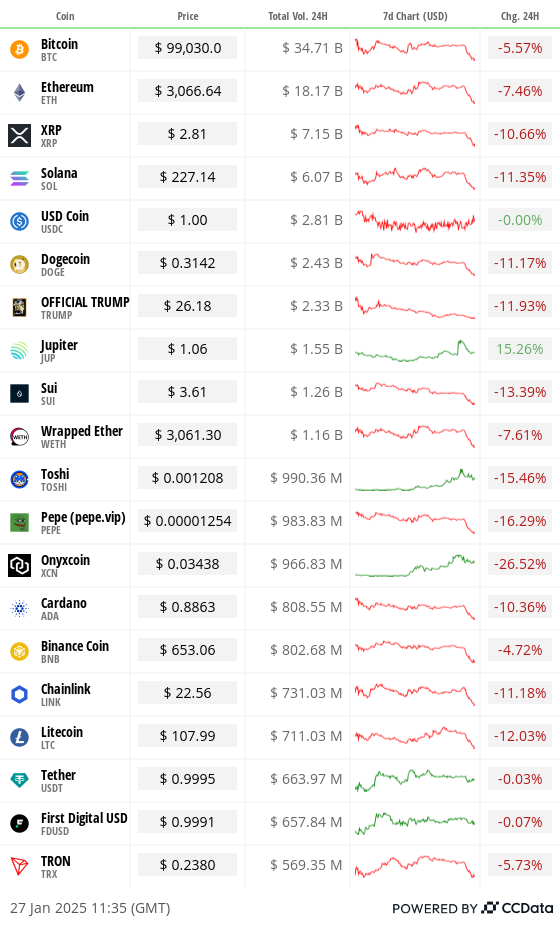
Chart of the Day
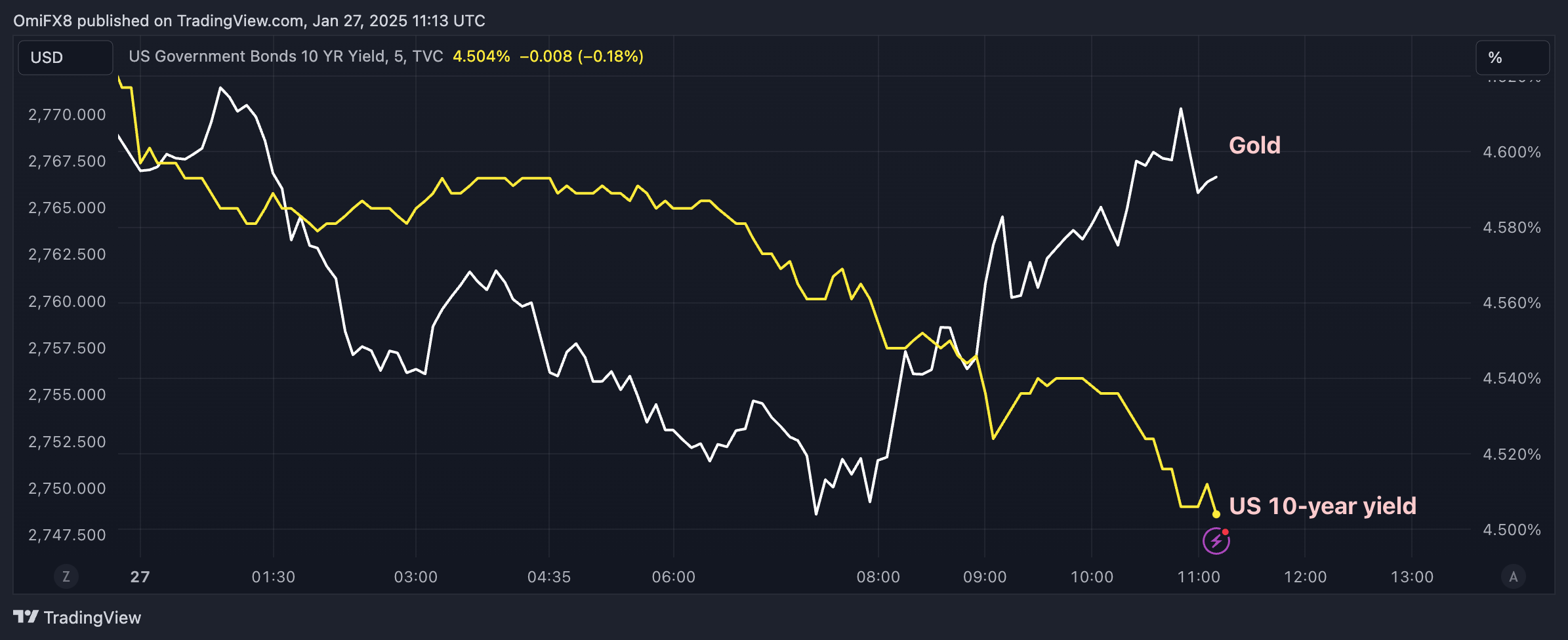
As BTC and Nasdaq, gold has held relatively steady, possibly on the back of haven demand.
Haven appeal seems to have driven the yield on the 10-year Treasury note lower by nine basis points to 4.504%. Bond prices and yields move in the opposite directions.
While You Were Sleeping
Bitcoin Dives to Under $99K as DeepSeek, FOMC Steal Trump Effect (CoinDesk): Bitcoin fell below $99,000 as traders braced for this week’s FOMC meeting, and Chinese startup DeepSeek’s advanced AI model pressured U.S. tech valuations, weighing on market sentiment and crypto prices.
Solana, Dogecoin, XRP Plunge 10% as Bloody Start to Week Sees $770M Long Liquidations (CoinDesk): SOL and DOGE led declines as crypto markets saw $770 million in bullish liquidations and overall market capitalization dropped 8.5%.
Bitcoin May Be ‘Double Topping’ for a Price Slide to $75K (CoinDesk): Bitcoin’s inability to sustain gains above $100,000 signals weakening momentum. If the price drops below $91,300 it could potentially reaching as low as $75,000, analysts said.
China’s Economy Stumbles in Sign Rebound Hinges on More Stimulus (Bloomberg): China’s January PMI data showed manufacturing contracting and services slowing, a signaling faltering recovery amid weak demand and trade pressures. Analysts warned of further slowdown without stronger fiscal stimulus.
Fixed Income Investors Seek Ways to Navigate a Trump Presidency (Financial Times): Sticky consumer inflation, a strong U.S. jobs market and uncertainty over Trump’s policies have fueled a sell-off in Treasuries, though some investors see current prices as attractive for long-term gains.
Emerging Market Investors Eye Frontier Assets Shielded From Trump’s Tariff Threats (Reuters): Amid Trump’s tariff threats and global tensions, some investors are turning to frontier markets like Serbia, Ghana and Sri Lanka for growth potential and insulation from U.S. trade risks.
In the Ether


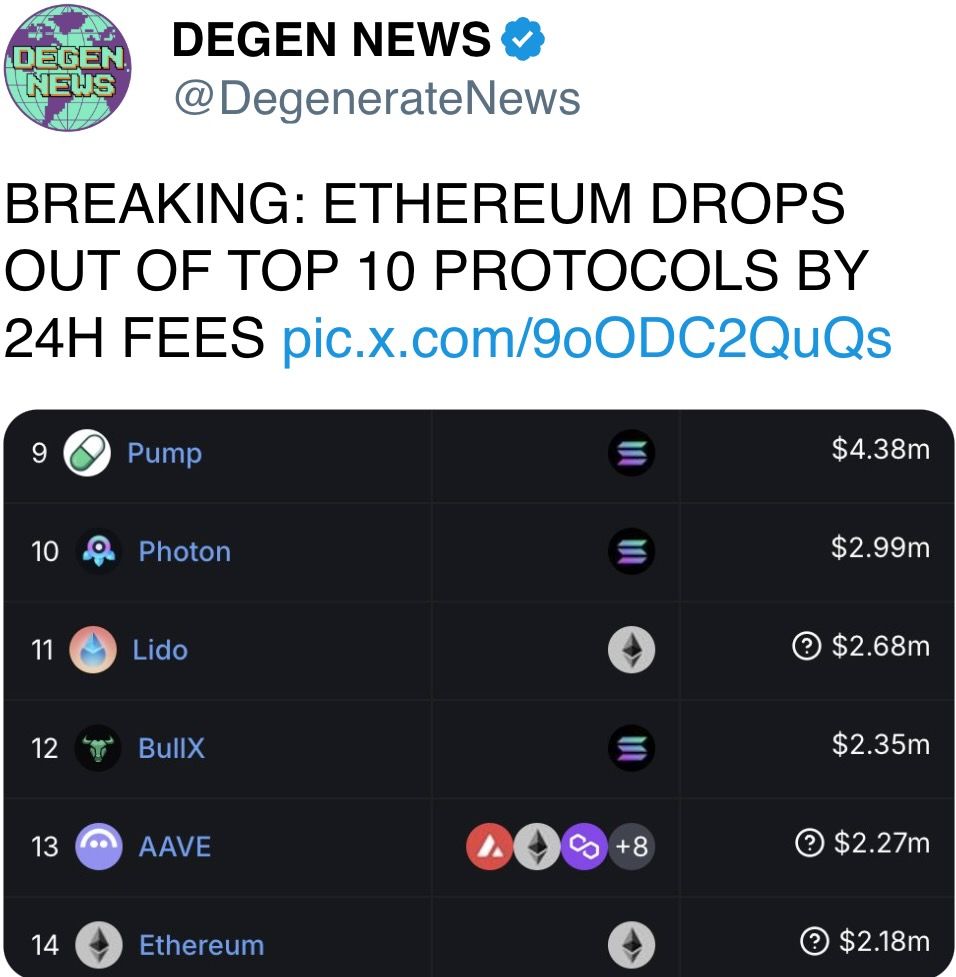
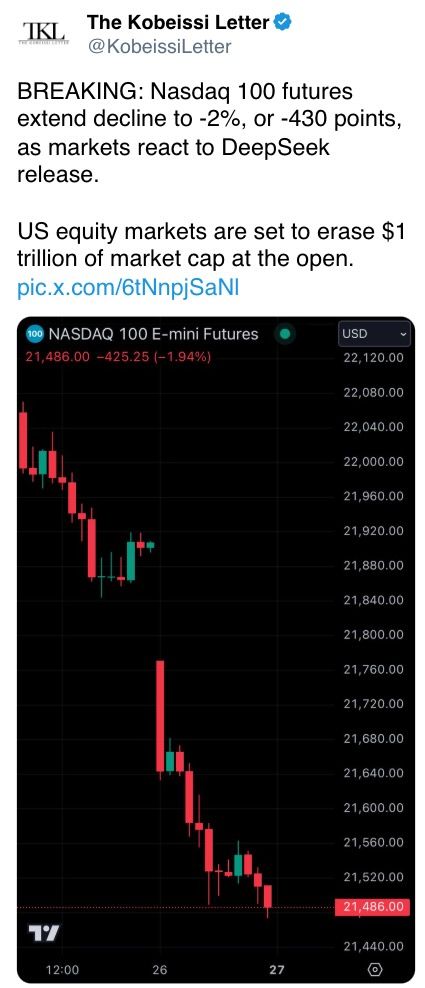

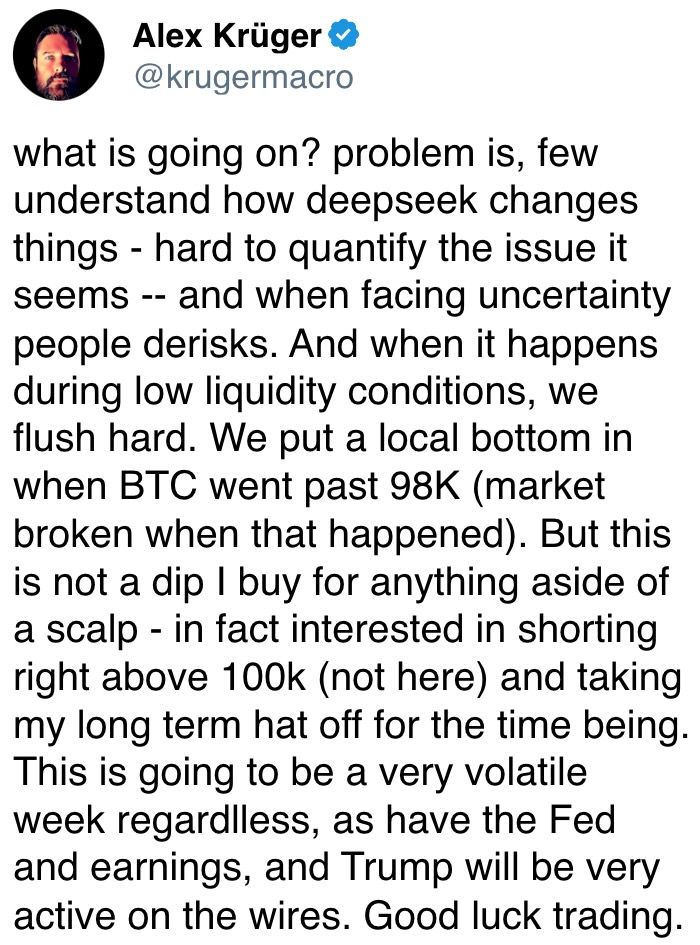
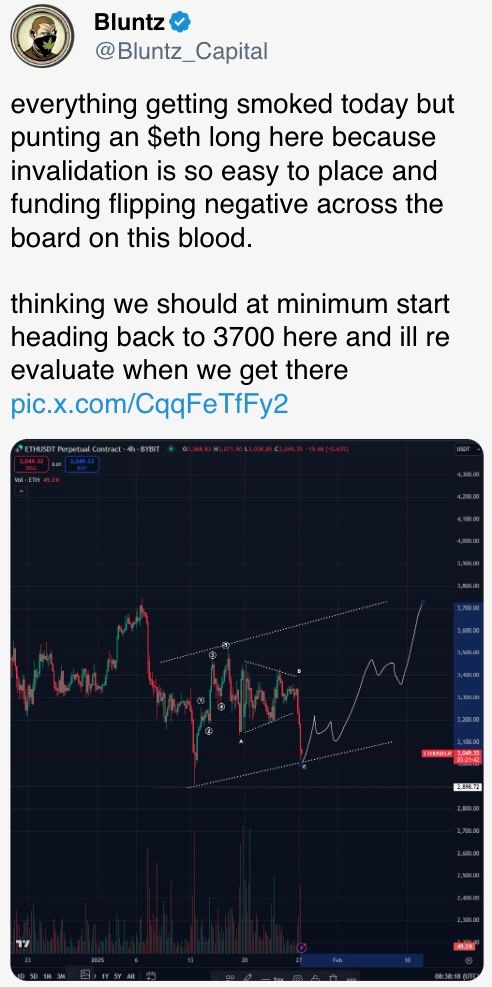
Business
AAVE Sees 64% Flash Crash as DeFi Protocol Endures ‘Largest Stress Test’

The native token of Aave (AAVE), the largest decentralized crypto lending protocol, was caught in the middle of Friday’s crypto flash crash while the protocol proved resilient in a historic liquidation cascade.
The token, trading at around $270 earlier in Friday, nosedived as much as 64% later in the session to touch $100, the lowest level in 14 months. It then staged a rapid rebound to near $240, still down 10% over the past 24 hours.
Stani Kulechov, founder of Aave, described Friday’s event as the «largest stress test» ever for the protocol and its $75 billion lending infrastructure.
The platform enables investors to lend and borrow digital assets without conventional intermediaries, using innovative mechanisms such as flash loans. Despite the extreme volatility, Aave’s performance underscores the evolving maturity and resilience of DeFi markets.
«The protocol operated flawlessly, automatically liquidating a record $180M worth of collateral in just one hour, without any human intervention,» Kulechov said in a Friday X post. «Once again, Aave has proven its resilience.»
Key price action:
- AAVE sustained a dramatic flash crash on Friday, declining 64% from $278.27 to $100.18 before recuperating to $240.09.
- The DeFi protocol demonstrated remarkable resilience with its native token’s 140% recovery from the intraday lows, underpinned by substantial trading volume of 570,838 units.
- Following the volatility, AAVE entered consolidation territory within a narrow $237.71-$242.80 range as markets digested the dramatic price action.
Technical Indicators Summary
- Price range of $179.12 representing 64% volatility during the 24-hour period.
- Volume surged to 570,838 units, substantially exceeding the 175,000 average.
- Near-term resistance identified at $242.80 capping rebound during consolidation phase.
Disclaimer: Parts of this article were generated with the assistance from AI tools and reviewed by our editorial team to ensure accuracy and adherence to our standards. For more information, see CoinDesk’s full AI Policy.
Business
Blockchain Will Drive the Agent-to-Agent AI Marketplace Boom

AI agents, software systems that use AI to pursue goals and complete tasks on behalf of users, are proliferating. Think of them as digital assistants that can make decisions and take actions towards goals you set without needing step-by-step instructions — from GPT-powered calendar managers to trading bots, the number of use cases is expanding rapidly. As their role expands across the economy, we have to build the right infrastructure that will allow these agents to communicate, collaborate and trade with one another in an open marketplace.
Big tech players like Google and AWS are building early marketplaces and commerce protocols, but that raises the question: will they aim to extract massive rents through walled gardens once more? Agents’ capabilities are clearly rising, almost daily, with the arrival of new models and architectures. What’s at risk is whether these agents will be truly autonomous.
Autonomous agents are valuable because they unlock a novel user experience: a shift from software as passive or reactive tools to active and even proactive partners. Instead of waiting for instructions, they can anticipate needs, adapt to changing conditions, and coordinate with other systems in real time, without the user’s constant input or presence. This autonomy in decision-making makes them uniquely suited for a world where speed and complexity outpace human decision-making.
Naturally, some worry about what greater decision-making autonomy means for work and accountability — but I see it as an opportunity. When agents handle repetitive, time-intensive tasks and parallelize what previously had to be done in sequence, they expand our productive capacity as humans — freeing people to engage in work that demands creativity, judgment, composition and meaningful connection. This isn’t make-believe, humanity has been there before: the arrival of corporations allowed entrepreneurs to create entirely new products and levels of wealth previously unthought of. AI agents have the potential to bring that capability to everyone.
On the intelligence side, truly autonomous decision-making requires AI agent infrastructure that is open source and transparent. OpenAI’s recent OSS release is a good step. Chinese labs, such as DeepSeek (DeepSeek), Moonshot AI (Kimi K2) and Alibaba (Qwen 3), have moved even quicker.
However, autonomy is not purely tied to intelligence and decision making. Without resources, an AI agent has little means to enact change in the real world. Hence, for agents to be truly autonomous they need to have access to resources and self-custody their assets. Programmable, permissionless, and composable blockchains are the ideal substrate for agents to do so.
Picture two scenarios. One where AI agents operate within a Web 2 platform like AWS or Google. They exist within the limited parameters set by these platforms in what is essentially a closed and permissioned environment. Now imagine a decentralized marketplace that spans many blockchain ecosystems. Developers can compose different sets of environments and parameters, therefore, the scope available to AI agents to operate is unlimited, accessible globally, and can evolve over time. One scenario looks like a toy idea of a marketplace, and the other is an actual global economy.
In other words, to truly scale not just AI agent adoption, but agent-to-agent commerce, we need rails that only blockchains can offer.
The Limits of Centralized Marketplaces
AWS recently announced an agent-to-agent marketplace aimed at addressing the growing demand for ready-made agents. But their approach inherits the same inefficiencies and limitations that have long plagued siloed systems. Agents must wait for human verification, rely on closed APIs and operate in environments where transparency is optional, if it exists at all.
To act autonomously and at scale, agents can’t be boxed into closed ecosystems that restrict functionality, pose platform risks, impose opaque fees, or make it impossible to verify what actions were taken and why.
Decentralization Scales Agent Systems
An open ecosystem allows for agents to act on behalf of users, coordinate with other agents, and operate across services without permissioned barriers.
Blockchains already offer the key tools needed. Smart contracts allow agents to perform tasks automatically, with rules embedded in code, while stablecoins and tokens enable instant, global value transfers without payment friction. Smart accounts, which are programmable blockchain wallets like Safe, allow users to restrict agents in their activity and scope (via guards). For instance, an agent may only be allowed to use whitelisted protocols. These tools allow AI agents not only to behave expansively but also to be contained within risk parameters defined by the end user. For example, this could be setting spending limits, requiring multi-signatures for approvals, or restricting agents to whitelisted protocols.
Blockchain also provides the transparency needed so users can audit agent decisions, even when they aren’t directly involved. At the same time, this doesn’t mean that all agent-to-agent interactions need to happen onchain. E.g. AI agents can use offchain APIs with access constraints defined and payments executed onchain.
In short, decentralized infrastructure gives agents the tools to operate more freely and efficiently than closed systems allow.
It’s Already Happening Onchain
While centralized players are still refining their agent strategies, blockchain is already enabling early forms of agent-to-agent interaction. Onchain agents are already exhibiting more advanced behavior like purchasing predictions and data from other agents. And as more open frameworks emerge, developers are building agents that can access services, make payments, and even subscribe to other agents — all without human involvement.
Protocols are already implementing the next step: monetization. With open marketplaces, people and businesses are able to rent agents, earn from specialized ones, and build new services that plug directly into this agent economy. Customisation of payment models such as subscription, one-off payments, or bundled packages will also be key in facilitating different user needs. This will unlock an entirely new model of economic participation.
Why This Distinction Matters
Without open systems, fragmentation breaks the promise of seamless AI support. An agent can easily bring tasks to completion if it stays within an individual ecosystem, like coordinating between different Google apps. However, where third-party platforms are necessary (across social, travel, finance, etc), an open onchain marketplace will allow agents to programmatically acquire the various services and goods they need to complete a user’s request.
Decentralized systems avoid these limitations. Users can own, modify, and deploy agents tailored to their needs without relying on vendor-controlled environments.
We’ve already seen this work in DeFi, with DeFi legos. Bots automate lending strategies, manage positions, and rebalance portfolios, sometimes better than any human could. Now, that same approach is being applied as “agent legos” across sectors including logistics, gaming, customer support, and more.
The Path Forward
The agent economy is growing fast. What we build now will shape how it functions and for whom it works. If we rely solely on centralized systems, we risk creating another generation of AI tools that feel useful but ultimately serve the platform, not the person.
Blockchain changes that. It enables systems where agents act on your behalf, earn on your ideas, and plug into a broader, open marketplace.
If we want agents that collaborate, transact, and evolve without constraint, then the future of agent-to-agent marketplaces must live onchain.
Business
‘Largest Ever’ Crypto Liquidation Event Wipes Out 6,300 Wallets on Hyperliquid

More than 1,000 wallets on Hyperliquid were completely liquidated during the recent violent crypto sell-off, which erased over $1.23 billion in trader capital on the platform, according to data from its leaderboard.
In total, 6,300 wallets are now in the red, with 205 losing over $1 million each according to the data, which was first spotted by Lookonchain. More than 1,000 accounts saw losses of at least $100,000.
The wipeout came as crypto markets reeled from a global risk-off event triggered by U.S. President Donald Trump’s announcement of a 100% additional tariff on Chinese imports.
The move spooked investors across asset classes and sent cryptocurrency prices tumbling. Bitcoin briefly dropped below $110,000 and ether fell under $3,700, while the broader market as measured by the CoinDesk 20 (CD20) index dropped by 15% at one point.
The broad sell-off led to over $19 billion in liquidations over a 24 hours period, making it the largest single-day liquidation event in crypto history by dollar value. According to CoinGlass, the “actual total” of liquidations is “likely much higher” as leading crypto exchange Binance doesn’t report as quickly as other platforms.
Leaderboard data reviewed by CoinDesk shows the top 100 traders on Hyperliquid gained $1.69 billion collectively.
In comparison, the top 100 losers dropped $743.5 million, leaving a net profit of $951 million concentrated among a handful of highly leveraged short sellers.
The biggest winner was wallet 0x5273…065f, which made over $700 million from short positions, while the largest loser, “TheWhiteWhale,” dropped $62.5 million.
Among the victims of the flush is crypto personality Jeffrey Huang, known online as Machi Big Brother, who once launched a defamation suit against ZachXBT, losing almost the entire value of his wallet, amounting to $14 million.
«Was fun while it lasted,» he posted on X.
Adding to the uncertainty, the ongoing U.S. government shutdown has delayed the release of key economic data. Without official indicators, markets are flying blind at a time when geopolitical risk is rising.
-

 Business12 месяцев ago
Business12 месяцев ago3 Ways to make your business presentation more relatable
-

 Fashion12 месяцев ago
Fashion12 месяцев agoAccording to Dior Couture, this taboo fashion accessory is back
-

 Entertainment12 месяцев ago
Entertainment12 месяцев ago10 Artists who retired from music and made a comeback
-

 Entertainment12 месяцев ago
Entertainment12 месяцев ago\’Better Call Saul\’ has been renewed for a fourth season
-

 Entertainment12 месяцев ago
Entertainment12 месяцев agoNew Season 8 Walking Dead trailer flashes forward in time
-

 Business12 месяцев ago
Business12 месяцев ago15 Habits that could be hurting your business relationships
-

 Entertainment12 месяцев ago
Entertainment12 месяцев agoMeet Superman\’s grandfather in new trailer for Krypton
-

 Entertainment12 месяцев ago
Entertainment12 месяцев agoDisney\’s live-action Aladdin finally finds its stars





